Reminiscing
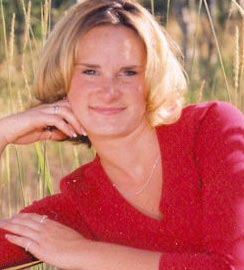
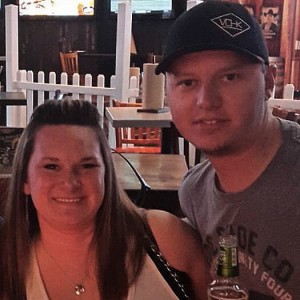 I first met my niece, Amanda Reed in 2002, when she was a 16-year-old girl with “stars in her eyes” as they say. Her dad, Mike Reed married my sister, Caryl that year, and they became a blended family. Life was mostly in her future then, because she was still in high school, but that was 20 years ago, and a lot has changed. Amanda went to work at the Rawlins National Bank at a young age and has worked her way up to the pretty prestigious position of BSA Agent, which is a part of the law enforcement area of the bank. She is involved in deterring fraud, money laundering, and such. I don’t claim to know all she does, but I know that it is an important part of the banking system.
I first met my niece, Amanda Reed in 2002, when she was a 16-year-old girl with “stars in her eyes” as they say. Her dad, Mike Reed married my sister, Caryl that year, and they became a blended family. Life was mostly in her future then, because she was still in high school, but that was 20 years ago, and a lot has changed. Amanda went to work at the Rawlins National Bank at a young age and has worked her way up to the pretty prestigious position of BSA Agent, which is a part of the law enforcement area of the bank. She is involved in deterring fraud, money laundering, and such. I don’t claim to know all she does, but I know that it is an important part of the banking system.
Also, since high school, she and her partner, Sean Mortensen have a little family of their own, with their daughter Jadyn coming on the scene almost 18 years ago. They have done and exceptional job of raising their beautiful girl, who will be going to the University of Wyoming in the fall on a rodeo scholarship.
That said, Amanda and Sean are about to become empty nesters, and I just wonder how they will feel about that, because I have really never seen parents who have included their child in every aspect of their lives like these two have. Jadyn is a very well-adjusted kid, because of how her parents raised her, and she is someone they can both be very proud of. Now, with Jadyn off to college, life is about to take another turn for Amanda and Sean.
They have always been involved in whatever Jadyn is doing, and she was involved in their activities. From Summer sports to Winter sports and everything in between, this active family stayed very busy, and I’m sure that even with Jadyn away at college, that will not change. When they aren’t traveling to some of her rodeo events, I’m sure they will still be hanging out with their large group of friends at the lake or in the mountains, 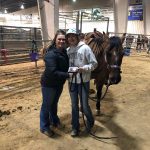
 depending on their plans for the day and the season it is. Amanda and Sean have a very active social life, and they are always on the go. The only difference now will be that they will have one less person in their entourage, and while they are happy for their daughter, I’m sure Amanda and Sean are a little bit sad for themselves too. Being an empty nester is an adjustment, no matter how you slice it. Today is Amanda’s birthday. Happy birthday Amanda!! Have a great day!! We love you!!
depending on their plans for the day and the season it is. Amanda and Sean have a very active social life, and they are always on the go. The only difference now will be that they will have one less person in their entourage, and while they are happy for their daughter, I’m sure Amanda and Sean are a little bit sad for themselves too. Being an empty nester is an adjustment, no matter how you slice it. Today is Amanda’s birthday. Happy birthday Amanda!! Have a great day!! We love you!!
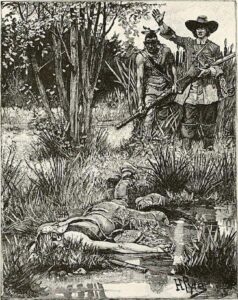 There have been many deadly wars in American history, but the deadliest war of them all took place during the 1670s. Technically, that was before the United States was even a nation. King Philip’s War, named for Metacom, the Wampanoag chief who adopted the name Philip because of the friendly relations between his father Massasoit and the Mayflower Pilgrims. The war pitted colonists and their indigenous allies (members of the Mohegan and Mohawk nations) in New England, against Philip’s (Metacom’s) Indigenous populations who didn’t want to be told what to do by the colonists in America. King Philip’s War was sometimes called the First Indian War, Metacom’s War, Metacomet’s War, Pometacomet’s Rebellion, or Metacom’s Rebellion. The conflict lasted from 1675 to 1678. The war continued in the most northern reaches of New England until the signing of the Treaty of Casco Bay on April 12, 1678.
There have been many deadly wars in American history, but the deadliest war of them all took place during the 1670s. Technically, that was before the United States was even a nation. King Philip’s War, named for Metacom, the Wampanoag chief who adopted the name Philip because of the friendly relations between his father Massasoit and the Mayflower Pilgrims. The war pitted colonists and their indigenous allies (members of the Mohegan and Mohawk nations) in New England, against Philip’s (Metacom’s) Indigenous populations who didn’t want to be told what to do by the colonists in America. King Philip’s War was sometimes called the First Indian War, Metacom’s War, Metacomet’s War, Pometacomet’s Rebellion, or Metacom’s Rebellion. The conflict lasted from 1675 to 1678. The war continued in the most northern reaches of New England until the signing of the Treaty of Casco Bay on April 12, 1678.
Massasoit, Metacom’s father had maintained a long-standing alliance with the colonists…since the days of the Mayflower, when the Wampanoag Indians and the pilgrims helped each other survive that first awful winter. When Metacom (1638–1676), Massasoit’s younger son, became tribal chief in 1662 after Massasoit’s death, he forsook his father’s alliance between the Wampanoags and the colonists after repeated violations by the colonists. The colonists insisted that the 1671 peace agreement should include the surrender of Native guns. They felt threatened by armed Indians. Tensions increased when three Wampanoags were hanged in Plymouth Colony in 1675 for the murder of another 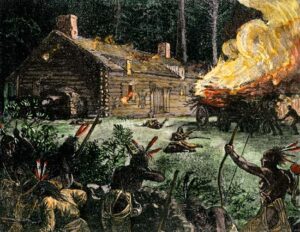 Wampanoag. Suddenly, native raiding parties were attacking homesteads and villages throughout Massachusetts, Rhode Island, Connecticut, and Maine. The attacks continued over the next six months, and the colonial militia retaliated. While the Narragansetts remained neutral, some of them participated in raids of colonial strongholds and militia, so colonial leaders claimed they were in violation of peace treaties.
Wampanoag. Suddenly, native raiding parties were attacking homesteads and villages throughout Massachusetts, Rhode Island, Connecticut, and Maine. The attacks continued over the next six months, and the colonial militia retaliated. While the Narragansetts remained neutral, some of them participated in raids of colonial strongholds and militia, so colonial leaders claimed they were in violation of peace treaties.
The colonies assembled the largest army New England had mustered to that date, consisting of 1,000 militia and 150 Native allies. In November of 1675, Governor Josiah Winslow marshaled them to attack the Narragansetts. They attacked and burned Native villages throughout Rhode Island territory, culminating with the attack on the Narragansetts’ main fort in the Great Swamp Fight. It is estimated that 600 Narragansetts were killed, and their coalition was taken over by Narragansett sachem Canonchet. They pushed back the borders of the Massachusetts Bay, Plymouth, and Rhode Island colonies, burning towns as they went, including Providence in March 1676. The colonial militia fought back hard and soon overwhelmed the Native coalition. By the end of the war, the Wampanoags and their Narragansett allies were almost completely wiped out. On 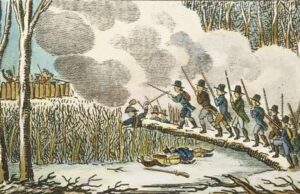 August 12, 1676, Metacom fled to Mount Hope, where he was killed by the militia. The war was the greatest tragedy in seventeenth-century New England. Many believe it was the deadliest war in Colonial American history. In the space of little more than a year, 12 of the region’s towns were destroyed and many more were damaged. The economy of Plymouth and Rhode Island Colonies was all but ruined. They lost over a tenth of all men available for military service. More than half of New England’s towns were attacked by Natives. Hundreds of Wampanoags and their allies were publicly executed or enslaved, and the Wampanoags were left effectively landless and destitute.
August 12, 1676, Metacom fled to Mount Hope, where he was killed by the militia. The war was the greatest tragedy in seventeenth-century New England. Many believe it was the deadliest war in Colonial American history. In the space of little more than a year, 12 of the region’s towns were destroyed and many more were damaged. The economy of Plymouth and Rhode Island Colonies was all but ruined. They lost over a tenth of all men available for military service. More than half of New England’s towns were attacked by Natives. Hundreds of Wampanoags and their allies were publicly executed or enslaved, and the Wampanoags were left effectively landless and destitute.
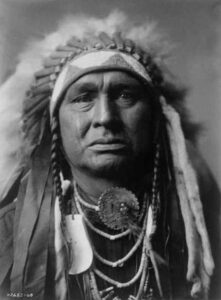 Joe Medicine Crow did not set out to become a war chief…much less the last surviving war chief, but when World War II drew the Unted States into the fight, Medicine Crow knew he couldn’t just sit back in his college dorm and refuse to help. Joe Medicine Crow was born on a reservation near Lodge Grass, Montana in 1913. Raised in the warrior tradition of the Crow, he was never one to shirk his duty in battle. He had some great warrior role models to fashion himself after, like his step-grandfather, who had been a scout for Custer at the infamous Battle of Little Bighorn, and his paternal grandfather Chief Medicine Crow who was one of the greatest Crow war heroes.
Joe Medicine Crow did not set out to become a war chief…much less the last surviving war chief, but when World War II drew the Unted States into the fight, Medicine Crow knew he couldn’t just sit back in his college dorm and refuse to help. Joe Medicine Crow was born on a reservation near Lodge Grass, Montana in 1913. Raised in the warrior tradition of the Crow, he was never one to shirk his duty in battle. He had some great warrior role models to fashion himself after, like his step-grandfather, who had been a scout for Custer at the infamous Battle of Little Bighorn, and his paternal grandfather Chief Medicine Crow who was one of the greatest Crow war heroes.
Before the war broke out, Medicine Crow enrolled at the University of Southern California and earned a master’s degree for his thesis, “The Effects of European Culture Contacts Upon the Economic, Social, and Religious Life of the Crow Indians.” With that, he became the first Crow to earn a master’s degree. After his graduation, he moved to Oregon to work at a Native American school and planned to pursue his Ph D, but then World War II broke out. Medicine Crow told a reporter for the Billings Gazette, “I had an uncle who had other plans for me…Uncle Sam.”
Medicine Crow hadn’t planned on entering the military, but he knew how to fight, and even while he was doing his duty to his country, he was still very aware of his family history. When he was a boy, his grandfather, Yellowtail put him through traditionally rigorous physical training meant to toughen him up. This included running in the snow barefoot and swimming in freezing rivers. His childhood was spent undergoing hardcore Spartan-style feats of strength, piledriving buffalo, riding horses bareback, swimming through mighty rivers, punching things, and running barefoot through snow-covered plains “uphill both ways.” He was taught to control his fear in the face of imminent peril, learned to hunt dangerous animals by himself, and trained his body to survive prolonged exposure to extreme temperatures. This training made him uniquely qualified for the hardships of a foot soldier. He came from a long line of famous warriors, and he kept them in mind when he was sent to Germany. He said, “I had a legacy to live up to.” Still, it was not something he told people about. That was his own legacy to live up to, and it was private. Throughout the war, he wore his war paint under his uniform, and he tucked a sacred yellow eagle feather under his helmet. He was determined to bring honor to his country and to his Crow people.
After the war, he worked for the Crow tribe and later became an appraiser for the Bureau of Indian Affairs, while also working as a Crow historian. While he didn’t get to go back to college, the University of Southern California (his alma mater) eventually awarded him an honorary doctorate in 2003, a degree I think he earned quite honorably.
“War Chief of the Crow Indians” isn’t a title that is given to just any warrior or chief. You don’t become a War Chief just because of your longevity of years or your physical strength. It’s an ancient, prestigious honorific bestowed only upon the bravest, the strongest warrior chiefs, and the only way to attain this hallowed title is by proving yourself in combat and unlocking the four achievements the Crow believed to be the most “insanely difficult” things a warrior can attempt in battle. These four major coups…leading a successful war party on a raid, capturing an enemy’s weapon, touching an enemy without killing him, and stealing an enemy’s horse. Some of those may sound odd to us, but to the Crow tribe, these were indeed major coups. These were difficult and dangerous tasks to attempt. In fact, they required that he put his life on the line by voluntarily bringing himself face-to-face with at least one warrior who is presumably in the process of actively trying to kill you without giving it a second thought. It was the Crow tribe’s way of ensuring that the chief leading them into battle was the bravest and best there was…and Joseph Medicine Crow was just that…the bravest and the best.
As an infantry scout, Private Medicine Crow got the opportunity to lead a group of men into battle in snow-covered battlefields of Western France while the Allies made their push from Paris towards Berlin…his first coup. It was during one particularly nasty portion of the battle for the Rhine, that Medicine Crow’s commanding officer ordered him to take a team of seven soldiers and lead them across a field of barbed wire, bullets, and artillery fire, grab some dynamite from an American position that had been utterly annihilated, and then assault the German bunkers and blow them up with TNT. It was a suicide mission, but according to Medicine Crow, his CO’s exact words were, “if anyone can do this, it’s probably you.”
His second and third coups followed quickly, when after being separated from his unit, Medicine Crow was sprinting through a back yard. He ran head on into a Nazi, who immediately lost his weapon. Not wanting to kill an unarmed man, Medicine Crow threw down his own weapon and proceeded to fist fight the Nazi. When the Nazi almost got the upper hand, Medicine Crow turned the tables and began to choke the life out of the guy…until the man started screaming for his mommy. That took “the kill” out of Medicine Crow, so he let the guy 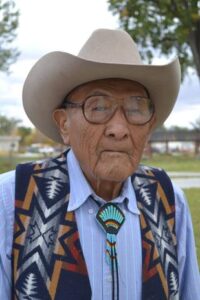 live. He took he German (and his rifle) as a prisoner of war.
live. He took he German (and his rifle) as a prisoner of war.
The fourth coup came in a rather unusual way. Joe and his men on a scouting mission deep behind enemy lines. While surveying the landscape for enemy troop movements, the small team of recon experts just happened to come across a small farm where some senior members of the German officer staff were hiding out…with their awesome thoroughbred racehorses. Seriously, how could Joseph Medicine Crow pass that up. So, he just had to steal them…and with that he had met all the requirements for becoming a “War Chief of the Crow Indians.” In August of 2009, Chief Medicine Crow was awarded the Presidential Medal of Freedom…the highest honor awarded to American civilians…for his combined military service and all the work he has done to help improve the lives of the people of the Crow people. The 95-year-old Medicine Crow personally led the ceremonial dance after the ceremony. Joseph Medicine Crow was the last surviving War Chief of the Crow Indians when he died in 2016, at 102 years old.

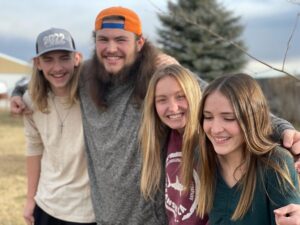 After high school, my grandnephew, Weston Moore decided that he wanted to make a chenge in his life. So, he and a couple of friends made the move last April from Powell, Wyoming to Butte, Montana. They just wanted to get out of a small town and try living in a bigger city for a while. It’s only 4.5 hours from Powell to Butte, but it’s far enough to make any kind of regular visits difficult. It’s enough to give these young men a taste of adult life, and they are doing very well with it. They have jobs, and they are making friends…basically settling in well. Weston has come home a couple of times for visits, but it’s just not the same for his family…parents Machelle and Steve Moore, and brother, Easton Moore. His family wishes it wasn’t quite so far.
After high school, my grandnephew, Weston Moore decided that he wanted to make a chenge in his life. So, he and a couple of friends made the move last April from Powell, Wyoming to Butte, Montana. They just wanted to get out of a small town and try living in a bigger city for a while. It’s only 4.5 hours from Powell to Butte, but it’s far enough to make any kind of regular visits difficult. It’s enough to give these young men a taste of adult life, and they are doing very well with it. They have jobs, and they are making friends…basically settling in well. Weston has come home a couple of times for visits, but it’s just not the same for his family…parents Machelle and Steve Moore, and brother, Easton Moore. His family wishes it wasn’t quite so far.


In February, Weston realized a longtime dream of his…adopting a fur baby. The family all met up in Billings for the day so Weston could pick up Kuvo…a Malamute puppy. Kuvo is so cute and very lovable. Apparently, Kuvo is quite a character, and keeps Weston and the guys quite entertained with his antics. Kuvo really is a beautiful dog. He reminds me of the dogs on “Snow Dogs.” Who knows maybe he will eventually have a team of Malamute dogs, and he can take them to Alaska for the Iditarod…well, you never know…it could happen.
Weston has been enjoying bachelorhood and is in no hurry to get tied down. He is just enjoying his freedom and relaxing. He recently got a new gun, so I’m sure he’s been out doing some target practice. And speaking of target practice, on one visit home, Weston and his dad went out in the back 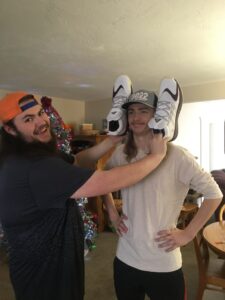
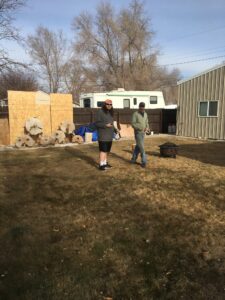 yard for some knife throwing practice. It’s an interesting idea, but not that one I think I would be very good at, but then the Moore family are very outdoorsy, so they like that stuff.
yard for some knife throwing practice. It’s an interesting idea, but not that one I think I would be very good at, but then the Moore family are very outdoorsy, so they like that stuff.
Weston also likes video games, like most people his age. And he loves posting funny stuff online. That doesn’t mean he never posts serious stuff too, but he has a great sense of humor, and the funny stuff makes him happy. Weston is usually wearing a smile, and that makes those around him smile too. People just naturally like to be around him. While his family misses him, we all wish him well in Butte, or wherever he might eventually land. Today is Weston’s birthday. Happy birthday Weston!! Have a great day!! We love you!!
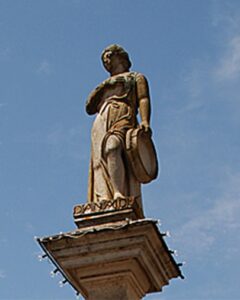 Sometimes, you can win a battle with nothing more than a good bluff. In 1369 AD, the town of Monção, in northern Portugal, which is famous for a local variety of red wines, became famous for something else…the medieval legend of Deu-la-Deu. King Peter of Castile and Leon, also known as “Peter the Cruel,” passed away that year, setting off a succession crisis. You would think that the succession to the throne would be pretty cut and dried, but King Peter had an illegitimate half-brother named Henry of Trastámara, who was crowned king. Portuguese King Ferdinand I, who was also one of the claimants. In retaliation for Ferdinand’s claim to the Spanish throne, Henry went to war with Portugal. Henry was determined to remove any thought of claiming the throne from King Ferdinand I and possibly take his life in the process.
Sometimes, you can win a battle with nothing more than a good bluff. In 1369 AD, the town of Monção, in northern Portugal, which is famous for a local variety of red wines, became famous for something else…the medieval legend of Deu-la-Deu. King Peter of Castile and Leon, also known as “Peter the Cruel,” passed away that year, setting off a succession crisis. You would think that the succession to the throne would be pretty cut and dried, but King Peter had an illegitimate half-brother named Henry of Trastámara, who was crowned king. Portuguese King Ferdinand I, who was also one of the claimants. In retaliation for Ferdinand’s claim to the Spanish throne, Henry went to war with Portugal. Henry was determined to remove any thought of claiming the throne from King Ferdinand I and possibly take his life in the process.
Part of Henry’s plan that year included laying siege to the Portuguese city of Monção, which was a fortified castle. They managed to catch the city while its lord, Vasco Gomes de Abreu, was away. The lord’s wife, Deu-la-Deu was put in charge of the defense. When I heard that, I wondered how they expected her to accomplish that, because most of the women, even the queens and ladies were pretty much there for their beauty and the children they bore…heirs to the throne. It just didn’t seem to fit into a role she would normally be an expert at, but that assumption proved to be very wrong. Deu-la-Deu would prove them all wrong.
Medieval castles were often designed to withstand long sieges in those days, but Monção’s food supplies were low, and the Spanish army was ready to starve the city. They had blocked the supply lines and were prepared to wait out the unfortunate inabitants of the city, who they fully expected to begin starving to death. The reality was that the people were about to starve to death, but the lady of the castle was a very wise woman. Deu-la- Deu came up with an amazing plan of defense, and one that would probably never have crossed the mind of the men, kings, lords, or army generals alike. Even though the city was almost out of food, the plan was to take the city’s remaining flour, bake it into two loaves of bread. Then Deu-la-Deu took them up to the castle walls, and threw them at the Spanish army, saying, “If you need any more, let us know.” The Spanish believed the city was well stocked and so the simply gave up and left. The siege was over, just like that. It is the funniest end to a siege I can imagine. Since that amazing incident, Deu-la-Deu Martins was considered a heroine in Portugal and a statue was erected in her honor.
Deu came up with an amazing plan of defense, and one that would probably never have crossed the mind of the men, kings, lords, or army generals alike. Even though the city was almost out of food, the plan was to take the city’s remaining flour, bake it into two loaves of bread. Then Deu-la-Deu took them up to the castle walls, and threw them at the Spanish army, saying, “If you need any more, let us know.” The Spanish believed the city was well stocked and so the simply gave up and left. The siege was over, just like that. It is the funniest end to a siege I can imagine. Since that amazing incident, Deu-la-Deu Martins was considered a heroine in Portugal and a statue was erected in her honor.
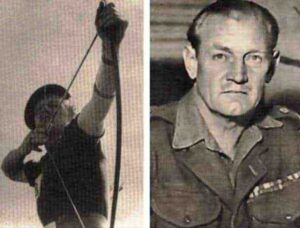
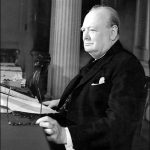 Most soldiers know that when you are trying to sneak up on your enemy, it’s probably best to leave the bagpipe playing at home. Nevertheless, John “Mad Jack” Churchill, who was one of the most colorful and unusual soldiers to fight in World War II, might find just about anything…you just never knew. The British-born “Mad Jack” Churchill had no known relation to Prime Minister Winston Spencer-Churchill, although I would not be surprised to find there was a relation. He was known for carrying a Scottish Claymore Sword into battle, and felt that any officer who didn’t have one while going into battle, was basically out of uniform. “Mad Jack”was also an avid archer and bagpipe player and brought both of these hobbies onto the battlefield.
Most soldiers know that when you are trying to sneak up on your enemy, it’s probably best to leave the bagpipe playing at home. Nevertheless, John “Mad Jack” Churchill, who was one of the most colorful and unusual soldiers to fight in World War II, might find just about anything…you just never knew. The British-born “Mad Jack” Churchill had no known relation to Prime Minister Winston Spencer-Churchill, although I would not be surprised to find there was a relation. He was known for carrying a Scottish Claymore Sword into battle, and felt that any officer who didn’t have one while going into battle, was basically out of uniform. “Mad Jack”was also an avid archer and bagpipe player and brought both of these hobbies onto the battlefield.
Churchill volunteered for Great Britain’s first-ever commando unit in 1941, and he participated in covert operations in Italy and Norway. In one Norway operation, he played his bagpipes on the landing craft as they approached the shore, then picked up his sword and attacked. In 1944, “Mad Jack” was on assignment in Yugoslavia to assist with the communist partisans under Josip “Tito” Broz, and that was when his infamous bagpipe incident happened.
During a mission to attack a German position on the Island of Brac, “Mad Jack” and his men advanced under heavy fire. In the end, he was the only one left alive. After running out of bullets, and in typical “Mad Jack” style, he picked up his bagpipe and played “Will Ye No Come Back Again?,l.” It was an 18th-century song celebrating the Jacobite Prince Charles III’s escape from being captured by the British monarchy.
Unimpressed, the Germans knocked him out with an explosion and captured him, but they spared his life…not because of his bagpipe prowess, however, but because they thought he was related to Prime Minister Winston Spencer-Churchill. They thought that having a relative of the prime minister would provide them with sone leverage. Unfortunately for them, as far as anyone knew there was no connection. “Mad Jack” was placed in a prison camp, from which he escaped captivity twice before making it home.
Churchill married Rosamund Margaret Denny, the daughter of Sir Maurice Edward Denny and granddaughter of Sir 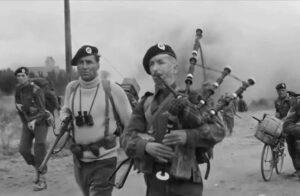
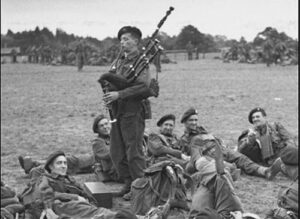 Archibald Denny, on March 8, 1941. They had two children, Malcolm John Leslie Churchill, born 1942, and Rodney Alistair Gladstone Churchill, born 1947. He also had a grandson named James Also stair Gladstone Churchill. “Mad Jack” lived a long and happy life. Nevertheless, I seriously doubt if any part of it was as crazy as the time he spent in World War I. He passed away on March 8, 1996 at 89 years old, in the county of Surrey.
Archibald Denny, on March 8, 1941. They had two children, Malcolm John Leslie Churchill, born 1942, and Rodney Alistair Gladstone Churchill, born 1947. He also had a grandson named James Also stair Gladstone Churchill. “Mad Jack” lived a long and happy life. Nevertheless, I seriously doubt if any part of it was as crazy as the time he spent in World War I. He passed away on March 8, 1996 at 89 years old, in the county of Surrey.
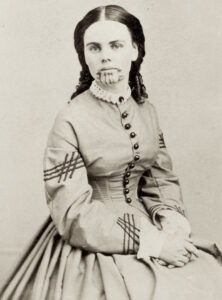
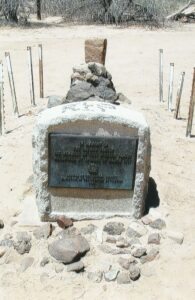 Mary Ann and Royce Oatman had seven children, and Mary Ann was pregnant with their eighth child in 1851, when she and Royce decided to move their family the Gila River area of California. The Oatman children ranged in age from one to 17, the eldest being Lucy Oatman. The family has only been on the trail for four days from their starting point if Maricopa Wells, when they were approached by a group of Native Americans who were asking for tobacco and food. Royce Oatman was hesitant to share too much with the small band of Yavapais, because of the lack of supplies. The Yavapaus saw this as stinginess, and became irate. The Yavapais attacked the Oatman family…clubbing them to death. All were killed except for three of the children. Lorenzo, who was 15 years old was left for dead, and 14-year-old Olive and 7-year-old Mary Ann, who were taken to be slaves for the Yavapais.
Mary Ann and Royce Oatman had seven children, and Mary Ann was pregnant with their eighth child in 1851, when she and Royce decided to move their family the Gila River area of California. The Oatman children ranged in age from one to 17, the eldest being Lucy Oatman. The family has only been on the trail for four days from their starting point if Maricopa Wells, when they were approached by a group of Native Americans who were asking for tobacco and food. Royce Oatman was hesitant to share too much with the small band of Yavapais, because of the lack of supplies. The Yavapaus saw this as stinginess, and became irate. The Yavapais attacked the Oatman family…clubbing them to death. All were killed except for three of the children. Lorenzo, who was 15 years old was left for dead, and 14-year-old Olive and 7-year-old Mary Ann, who were taken to be slaves for the Yavapais.
When Lorenzo woke up after the attack, he found his parents and most of his siblings dead, but he saw no sign of little Mary Ann or Olive. With great effort, Lorenzo made the hazardous trek to find help. He eventually reached a settlement, where his wounds were treated. When he had recovered, Lorenzo rejoined the emigrant train. Three days later the train reached the bodies of his slain family. The story was told far and wide In great detail in newspapers over the decades. Lorenzo said, “We buried the bodies of father, mother and babe in one common grave.” The men had no way of digging proper graves in the volcanic rocky soil, so they gathered the bodies together and formed a cairn over them. It has been said the remains were reburied several times and finally moved to the river for re-interment by early Arizona colonizer Charles Poston. I’m sure that was a source of relief for Lorenzo. He refused to give up hope that his sisters were alive. He determined never to give up the search for his only surviving siblings.
Olive and Mary Ann were held captive for one year by the Yavapais before they were traded to the Mohave people. Lorenzo was in the process of exhaustively attempting to recruit governmental help in searching for his sisters. The trade for the girls was initiated by the Mohave people. At first, the Yavapais refused, but the Mohave Chief Espaniole saw the girls and their poor treatment during a trading expedition. He tried to make a trade for the girls. The Yavapais refused, but the chief’s daughter, Topeka, was persistent and returned once more offering a trade for the girls. Eventually the Yavapais gave in and traded the girls for two horses, some vegetables, blankets, and beads. At some point after the girls went to be with the Mohave people, Mary Ann died from starvation. This happened in about 1855–1856, when Mary Ann was ten or eleven. It has been claimed that there was a drought in the region, and that the tribe experienced a dire shortage of food supplies. Olive would have died too, had not Aespaneo, the matriarch of the tribe, saved her life by making a gruel to sustain her.
Olive was left alone with the Mohave people for about four years. This was not the worst time in their captivity. The Mohave people tattooed the girls chins and arms, which was not a marking of a slave, but rather of family. The also told Olive that she could go to the village of the white people if she wanted, but they dared not go with her, because they feared for their lives for having kept her for so long. I suppose, she didn’t know anyone in that village either, so why go.
When Olive was 19 years old, Francisco, a Yuma Indian messenger, arrived at the village with a message from the authorities at Fort Yuma. They had heard that a white girl was living with the Mohaves, and the post commander requested her return, or to know the reason why she did not choose to return. The Mohave tried to resist, but after some discussion, in which Olive was included, the Mohaves decided to accept these terms, and Olive was escorted to Fort Yuma in a 20-day journey. Topeka (the daughter of Espianola and Aespaneo) went on the journey with her. Before entering the fort, Olive was given Western clothing lent by the wife of an army officer, as she was wearing a traditional Mohave skirt with no covering above her waist. Inside the fort, Olive was surrounded by cheering people. I wonder if she felt like cheering…or crying. Olive’s childhood friend Susan Thompson, whom she befriended again at this time, stated many years later that she believed Olive was “grieving” upon her return because she had been married to a Mohave man and had given birth to two boys. Of course, there is no record to substantiate that claim.
In November 1865, Olive Oatman married a cattleman named John B. Fairchild. They met at a lecture she was giving alongside in Michigan. Fairchild had lost his brother to an attack by Native Americans during a cattle drive in Arizona in 1854, the time in which Oatman was living among the Mohave. Olive began wearing a veil to cover her famous tattoo and became involved in charity work. She was particularly interested in helping a local 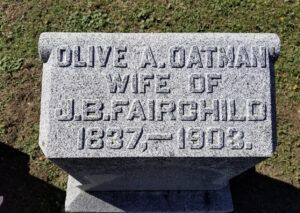
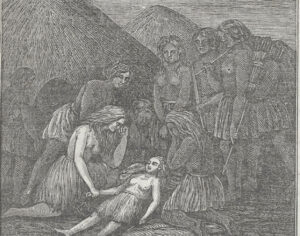 orphanage. She and Fairchild never had their own children, but they did adopt a little girl and named her Mary Elizabeth after their mothers, nicknaming her Mamie.
orphanage. She and Fairchild never had their own children, but they did adopt a little girl and named her Mary Elizabeth after their mothers, nicknaming her Mamie.
Olive’s brother, Lorenzo died on October 8, 1901. Less than 2 years, Olive Oatman Fairchild died of a heart attack on March 20, 1903, at the age of 65. She is buried at the West Hill Cemetery in Sherman, Texas.
Oh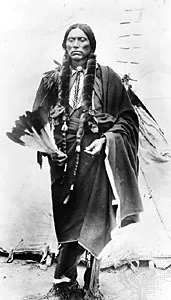 The great Comanche chief and war leader, Quanah Parker became a leader at a young age, and he was known for his bravery and his aggression as a warrior. I was drawn to this chief mostly because of his unusual name…both first and last. The first name was one I had never heard before, and the last seemed unusual for an Indian. Parker was born around 1848, near Wichita Falls, Texas, and died February 23, 1911, at Cache, near Fort Sill, Oklahoma. Quanah was the son of Chief Peta Nocona and Cynthia Ann Parker, a white woman captured by the Comanches as a child. Quanah is a Native American name that means “fragrant, or sweet smelling.” Quanah later added his mother’s surname to his given name. Their family was very happy until 1860, when the Texas Rangers attacked their encampment on the Pease River. While the stories of this event vary, there is no doubt that changed Quanah’s family forever, when the Rangers decided that Cynthia Ann and her young daughter, Prairie Flower should be returned to her people, even though that was against her wishes. It is believed that Quanah and Nocona were not there when the raid took place.
The great Comanche chief and war leader, Quanah Parker became a leader at a young age, and he was known for his bravery and his aggression as a warrior. I was drawn to this chief mostly because of his unusual name…both first and last. The first name was one I had never heard before, and the last seemed unusual for an Indian. Parker was born around 1848, near Wichita Falls, Texas, and died February 23, 1911, at Cache, near Fort Sill, Oklahoma. Quanah was the son of Chief Peta Nocona and Cynthia Ann Parker, a white woman captured by the Comanches as a child. Quanah is a Native American name that means “fragrant, or sweet smelling.” Quanah later added his mother’s surname to his given name. Their family was very happy until 1860, when the Texas Rangers attacked their encampment on the Pease River. While the stories of this event vary, there is no doubt that changed Quanah’s family forever, when the Rangers decided that Cynthia Ann and her young daughter, Prairie Flower should be returned to her people, even though that was against her wishes. It is believed that Quanah and Nocona were not there when the raid took place.
Quanah Parker was the last chief of the Kwahadi (Quahadi) band. He mounted an unsuccessful war against white expansion in northwestern Texas between 1874 and 1875. When that failed, he became the main spokesman and peacetime leader of the Native Americans in the region, a role which he performed for 30 years.
Quanah was a tall and muscular man, who became a full warrior at age 15. His reputation as an aggressive and fearless fighter was established after a series of successful raids. He became a war chief at a relatively young age as well, having gained the respect of his people. Quanah moved between several Comanche bands before joining the fierce Kwahadi, who were particularly bitter enemies of the hunter. The white Buffalo hunters had appropriated the best land on the Texas frontier and were decimating the buffalo herds. In order to stem the onslaught of Comanche attacks on settlers and travelers, the US government relegated the Indians to reservations in 1867. Quanah and his band refused to cooperate and continued their raids. Attempts by the US military to locate them were unsuccessful. In June 1874 Quanah and Isa-Tai, a medicine man who claimed to have a potion that would protect the Indians from bullets, gathered 250–700 warriors from among the Comanche, Cheyenne, and Kiowa and attacked about 30 white buffalo hunters quartered at Adobe Walls, Texas. The raid was a failure for the Kwahadi because a saloon owner had allegedly been warned of the attack, and the US military retaliated in force in what became known as the Red River Indian War. Quanah’s group held out on the Staked Plains for almost a year before he finally surrendered at Fort Sill.
Eventually Quanah agreed to settle on a reservation in southwestern Oklahoma, and he persuaded other Comanche bands to conform too. He soon became known as the principal chief of all Comanche. It was a position that had never existed before, and so was a great honor. As the chief of all Comanche, over the next three decades, he was the main interpreter of white civilization to his people, encouraging education and agriculture. He also tried to be an advocate on behalf of the Comanche, and soon became a successful businessman as well. Quanah also maintained elements of his own Indian culture, including polygamy, and he played a major role in creating a Peyote Religion that spread from 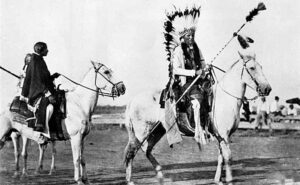 the Comanche to other tribes. He soon became a national figure, developing friendships with numerous notable men, including President Theodore Roosevelt, who invited Quanah to his inauguration in 1905. Roosevelt also visited Quanah at the chief’s home, a 10-room residence known as Star House, in Cache, Oklahoma.
the Comanche to other tribes. He soon became a national figure, developing friendships with numerous notable men, including President Theodore Roosevelt, who invited Quanah to his inauguration in 1905. Roosevelt also visited Quanah at the chief’s home, a 10-room residence known as Star House, in Cache, Oklahoma.
Quanah passed away in 1911, and was buried next to his mother, whose assimilation back into white civilization had been very difficult. Her white family blocked her repeated attempts to rejoin the Comanche, and in 1864 Prairie Flower died. Cynthia Ann was miserable and reportedly starved herself to death in 1870.
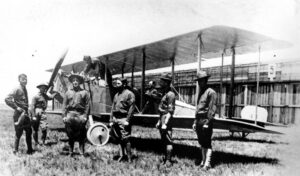 Imagine a time when there was no air force, or for that matter, airplanes. Of course, for those of us living today, that would be very hard to imagine…in fact, maybe impossible. Nevertheless, before the Wright brothers made flight possible, there was not only no planes, but no air force. Then, in 1914, things were about to change forever.
Imagine a time when there was no air force, or for that matter, airplanes. Of course, for those of us living today, that would be very hard to imagine…in fact, maybe impossible. Nevertheless, before the Wright brothers made flight possible, there was not only no planes, but no air force. Then, in 1914, things were about to change forever.
The First Aero Squadron was formed in 1914. It was organized after the start of World War I, but it was first used because of the Mexican revolutionary, Pancho Villa, who was initially a bandit, but later became a general in the Mexican Revolution. He was a key figure in the revolutionary violence that forced out President Porfirio Díaz and brought Francisco Madero to power in 1911. Pancho Villa was an excellent guerrilla leader who fought against the regimes of both of those men. After 1914, he engaged in civil war and banditry. He became notorious in the United States for his attack on Columbus, New Mexico, in 1916, and something had to be done
On March 9, 1916, Villa, who opposed American support for Mexican President Venustiano Carranza, led a band of several hundred guerrillas across the border on a raid of the town of Columbus, New Mexico. Seventeen Americans were killed in the battle. On March 15, President Woodrow Wilson ordered, US Brigadier General John J Pershing to launch a punitive expedition into Mexico to capture Villa. Four days later, the First Aero Squadron was sent into Mexico to scout and relay messages for General Pershing. On March 19, 1914, Eight Curtiss “Jenny” planes of the First Aero Squadron took off from Columbus, New Mexico, in the first combat air mission in United States history. The squadron was on a support mission for the 7,000 US troops who invaded Mexico to capture Villa.

Despite encountering numerous mechanical and navigational problems, the American pilots flew hundreds of missions for Pershing during which they gained important experience that would later be used by fliers over the battlefields of Europe. Unfortunately, during the 11-month mission, US forces failed to capture the elusive revolutionary, and Mexican resentment over US intrusion into their territory led to a diplomatic crisis. In late January 1917, with President Wilson under pressure from the Mexican government and more concerned with the war overseas than with bringing Villa to justice, the Americans were ordered home. The missions were over.
 Why would the United States secretly bomb a neutral nation in the middle of a war with an enemy nation? That is the question I have been asking myself concerning the Menu Bombings…the bombing of neutral Cambodia during the Vietnam war. It was thought that bombing supply routes in Cambodia would weaken the enemies of the United States. I’m not sure that worked exactly. It did cut off the supply line, but innocent people were caught in the crossfire. Nevertheless, the decision was made to bomb Cambodia, and also to keep it a secret from the American public, who would most likely feel about it the same way, I do. Intentionally bombing innocent people just rubs most of us the wrong way.
Why would the United States secretly bomb a neutral nation in the middle of a war with an enemy nation? That is the question I have been asking myself concerning the Menu Bombings…the bombing of neutral Cambodia during the Vietnam war. It was thought that bombing supply routes in Cambodia would weaken the enemies of the United States. I’m not sure that worked exactly. It did cut off the supply line, but innocent people were caught in the crossfire. Nevertheless, the decision was made to bomb Cambodia, and also to keep it a secret from the American public, who would most likely feel about it the same way, I do. Intentionally bombing innocent people just rubs most of us the wrong way.
On March 15, 1969, President Richard Nixon approved the plan to bomb Cambodia. The actual missions began 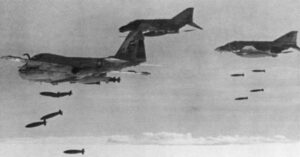 on March 18, 1969, when US B-52 bombers are diverted from their targets in South Vietnam to attack suspected communist base camps and supply areas in Cambodia for the first time in the war. This mission, originally intended to be called Operation Breakfast, and subsequent B-52 strikes inside Cambodia became known as the “Menu” bombings. The strikes included a total of 3,630 flights over Cambodia dropping 110,000 tons of bombs during a 14-month period through April 1970. This bombing of Cambodia and all follow up “Menu” operations were kept secret from the American public and the US Congress because Cambodia was considered a neutral nation. The missions had to be kept secret to avoid a public outcry…so, an intricate reporting system was established at the Pentagon to prevent disclosure of the bombing.
on March 18, 1969, when US B-52 bombers are diverted from their targets in South Vietnam to attack suspected communist base camps and supply areas in Cambodia for the first time in the war. This mission, originally intended to be called Operation Breakfast, and subsequent B-52 strikes inside Cambodia became known as the “Menu” bombings. The strikes included a total of 3,630 flights over Cambodia dropping 110,000 tons of bombs during a 14-month period through April 1970. This bombing of Cambodia and all follow up “Menu” operations were kept secret from the American public and the US Congress because Cambodia was considered a neutral nation. The missions had to be kept secret to avoid a public outcry…so, an intricate reporting system was established at the Pentagon to prevent disclosure of the bombing.

Somehow, the story was leaked by the New York Times in May of 1969, but there was little adverse public reaction. Now I find that incredible. The people were so “asleep” that they hardly noticed the bombing of a neutral country. It makes me wonder just how long the people have been asleep. How could people simply take no notice of such a huge violation of the rules of war. I’m sure there are things I don’t know about this war…lots of things, in fact, but I don’t think it is proper for our government to hide things for the people…especially such a big set of bombing missions on a neutral country. The people of this nation need to open our eyes and watch what our government is doing…before it’s too late.

